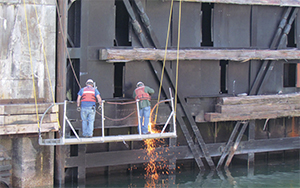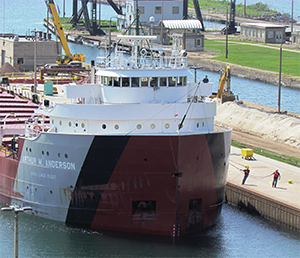Officials throughout the Great Lakes are intensifying their call for the federal government to approve a second large lock at Sault Ste. Marie, citing potential economic devastation if the need goes unmet.
Approximately 75 million metric tons of cargo traverse the locks at Sault Ste. Marie annually. All vessels funnel through one of two locks at the confluence of Lake Superior and the St. Marys River: the 800-foot-long, 80-foot-wide MacArthur Lock and the 1,200-foot-long, 110-foot-wide Poe Lock.
Seventy percent of U.S.-flag cargo ships are either too big or too wide to get through the MacArthur Lock, said Glen Nekvasil, vice president of the Lake Carriers’ Association.
“If something happened to the Poe Lock, the U.S.-flag fleet would basically go to anchor,” Nekvasil said. “The ships that are small enough to go through the MacArthur Lock could not even begin to meet the needs of commerce.”
According to a recent report from the U.S. Department of Homeland Security, a six-month closure of the Poe Lock could put the U.S. back in a recession even more severe than the economic downturn of 2008 and 2009, with an estimated 11 million jobs lost across the country and a $1.1 trillion loss in economic activity.
Approximately 75 percent of U.S. integrated steel production would cease within two to six weeks of the lock failing, the study forecasts. Roughly 80 percent of iron ore mining and nearly 100 percent of North American production of automobiles, appliances, heavy equipment and rail cars would then shut down.
In November 2015, after years of urging from stakeholders, the U.S. Army Corps of Engineers and the White House Office of Management and Budget allocated $1.35 million toward a cost-benefit study of a new Poe-sized lock in Sault Ste. Marie. The study is expected to be completed by the end of 2017, but some fear that’s not soon enough.
“It is a very, very pressing need and, unfortunately, even if Congress gave us the money today, you can’t build that lock overnight,” Nekvasil said. “If funded incrementally, it could take as long as 10 years.”
Although a second Poe-sized lock was authorized by Congress in 1986 and then again in 2007, funds were not appropriated and the project has been stalled by a flawed cost-benefit analysis, Nekvasil said. The analysis assumed the railroads could step in and move cargo if the Poe Lock went down.
“Our railroads can barely meet the needs of commerce as it is,” he said. “And equally important, a lot of the industries here on the Great Lakes do not even have rail connections.”
In May, U.S. Sens. Debbie Stabenow and Gary Peters, both of Michigan, sent a letter to the Army Corps of Engineers urging its swift completion of the study.
 |
|
Workers repair worn fenders on the lower gates of the MacArthur Lock in 2013. The oak beams lining the pier walls at the Soo Locks are continually being replaced. |
|
Courtesy U.S. Army Corps of Engineers |
“The recent meetings we have both held at the locks with the U.S. Army Corps of Engineers highlighted the profound harm that an outage would have on the economy and security of Michigan, the Great Lakes region and the entire nation,” wrote the senators. “We urge you to complete the Economic Re-evaluation Report as quickly as possible in order to begin the process of building a Poe-sized replacement lock. In producing this study, we also strongly encourage you to take into account the findings of the Homeland Security Department’s report.”
In a recent maritime strategy released by the Conference of Great Lakes and St. Lawrence Governors and Premiers, the lawmakers echoed the call for the second large lock and also urged the Army Corps of Engineers to immediately accelerate its study.
Mike Piskur, the conference’s program manager, said the group recognizes that there is limited federal funding for the $600 million project and it is trying to think creatively.
“We do talk (in the strategy) about the potential for a public-private partnership, where you’d have private construction and the project would still be managed by the Army Corp of Engineers,” Piskur said. “Things like that could potentially facilitate construction and potentially save on costs. We are also looking into the feasibility of building a second power plant at Sault Ste. Marie. Assuming that’s possible, the revenue potentially generated from that might be able to offset some of the construction and maintenance costs.”
The maritime strategy highlights aging infrastructure that has failed to receive sufficient investment over the years. The group also points out the need for a second heavy icebreaker for the Great Lakes. This has long been a concern of stakeholders and, in February, Congress approved construction of such a vessel. However, it still needs to approve funding for the estimated $240 million ship through a budget bill or the appropriations process.
Like the delayed construction of an additional Poe-sized lock, industry advocates say another heavy icebreaker is long overdue. Thick ice across the Great Lakes in 2013 and 2014 resulted in $1.1 billion in lost economic activity, according to the Lake Carriers’ Association.
“The Poe Lock is 47 years old,” Nekvasil said. “The MacArthur Lock was built in 1943. Most of the Coast Guard icebreakers here on the Great Lakes were built in the 1970s, so it is time for us to reinvest in the Great Lakes shipping industry.
“We’re doing it with our vessels. We typically spend $50 (million) to $60 million each winter tuning the boats and modernizing them. And it’s now time for the federal government to build that lock and build another heavy icebreaker.”

